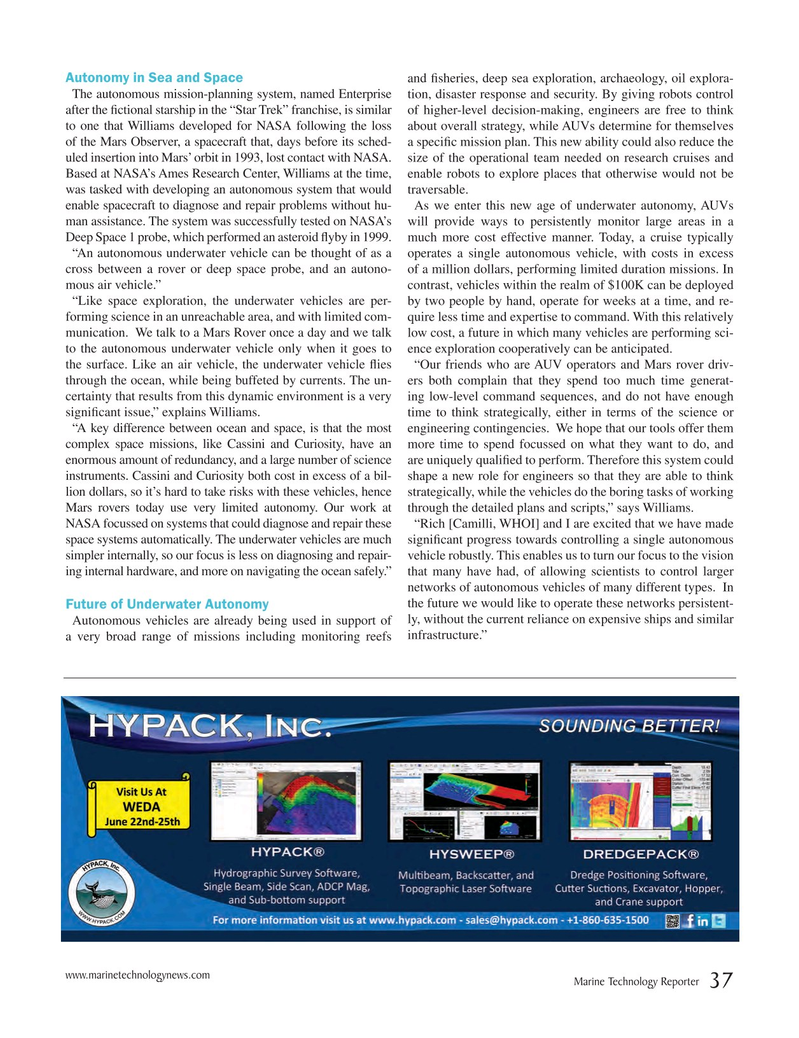
Page 37: of Marine Technology Magazine (June 2015)
Hydrographic Survey
Read this page in Pdf, Flash or Html5 edition of June 2015 Marine Technology Magazine
Autonomy in Sea and Space and ? sheries, deep sea exploration, archaeology, oil explora-
The autonomous mission-planning system, named Enterprise tion, disaster response and security. By giving robots control after the ? ctional starship in the “Star Trek” franchise, is similar of higher-level decision-making, engineers are free to think to one that Williams developed for NASA following the loss about overall strategy, while AUVs determine for themselves of the Mars Observer, a spacecraft that, days before its sched- a speci? c mission plan. This new ability could also reduce the uled insertion into Mars’ orbit in 1993, lost contact with NASA. size of the operational team needed on research cruises and
Based at NASA’s Ames Research Center, Williams at the time, enable robots to explore places that otherwise would not be was tasked with developing an autonomous system that would traversable. enable spacecraft to diagnose and repair problems without hu- As we enter this new age of underwater autonomy, AUVs man assistance. The system was successfully tested on NASA’s will provide ways to persistently monitor large areas in a
Deep Space 1 probe, which performed an asteroid ? yby in 1999. much more cost effective manner. Today, a cruise typically “An autonomous underwater vehicle can be thought of as a operates a single autonomous vehicle, with costs in excess cross between a rover or deep space probe, and an autono- of a million dollars, performing limited duration missions. In mous air vehicle.” contrast, vehicles within the realm of $100K can be deployed “Like space exploration, the underwater vehicles are per- by two people by hand, operate for weeks at a time, and re- forming science in an unreachable area, and with limited com- quire less time and expertise to command. With this relatively munication. We talk to a Mars Rover once a day and we talk low cost, a future in which many vehicles are performing sci- to the autonomous underwater vehicle only when it goes to ence exploration cooperatively can be anticipated.
the surface. Like an air vehicle, the underwater vehicle ? ies “Our friends who are AUV operators and Mars rover driv- through the ocean, while being buffeted by currents. The un- ers both complain that they spend too much time generat- certainty that results from this dynamic environment is a very ing low-level command sequences, and do not have enough signi? cant issue,” explains Williams. time to think strategically, either in terms of the science or “A key difference between ocean and space, is that the most engineering contingencies. We hope that our tools offer them complex space missions, like Cassini and Curiosity, have an more time to spend focussed on what they want to do, and enormous amount of redundancy, and a large number of science are uniquely quali? ed to perform. Therefore this system could instruments. Cassini and Curiosity both cost in excess of a bil- shape a new role for engineers so that they are able to think lion dollars, so it’s hard to take risks with these vehicles, hence strategically, while the vehicles do the boring tasks of working
Mars rovers today use very limited autonomy. Our work at through the detailed plans and scripts,” says Williams.
NASA focussed on systems that could diagnose and repair these “Rich [Camilli, WHOI] and I are excited that we have made space systems automatically. The underwater vehicles are much signi? cant progress towards controlling a single autonomous simpler internally, so our focus is less on diagnosing and repair- vehicle robustly. This enables us to turn our focus to the vision ing internal hardware, and more on navigating the ocean safely.” that many have had, of allowing scientists to control larger networks of autonomous vehicles of many different types. In the future we would like to operate these networks persistent-
Future of Underwater Autonomy
Autonomous vehicles are already being used in support of ly, without the current reliance on expensive ships and similar a very broad range of missions including monitoring reefs infrastructure.” www.marinetechnologynews.com
Marine Technology Reporter 37
MTR #5 (34-49).indd 37 MTR #5 (34-49).indd 37 6/11/2015 10:53:53 AM6/11/2015 10:53:53 AM

 36
36

 38
38
